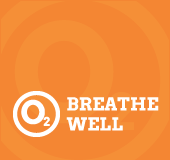Lung Cancer

Tobacco use is the number one cause of lung cancer, but people who don’t smoke may get lung cancer too. The most important thing you can do to lower your lung cancer risk is to quit smoking and avoid secondhand smoke.
What is Lung Cancer?
Lung cancer is a cancer that starts in the lungs. Your lungs are 2 sponge-like organs found in your chest. Your right lung is divided into 3 sections, called lobes. Your left lung has 2 lobes. The left lung is smaller because the heart takes up more room on that side of the body. The main functions of your lungs are to take in oxygen and to get rid of carbon dioxide, and this happens through breathing.
Types of Lung Cancer
There are 2 main types of lung cancer:
- Small cell lung cancer (SCLC): About 10% to 15% of all lung cancers are small cell lung cancer (SCLC), named for the size of the cancer cells when seen under a microscope. It is very rare for someone who has never smoked to have small cell lung cancer.
- Non-small cell lung cancer (NSCLC): About 85% to 90% of lung cancers are non-small cell lung cancer (NSCLC). The cells in the different subtypes of non-small cell lung cancer differ in size, shape, and chemical make-up. But they are grouped together because the approach to treatment and prognosis (outlook) are often very similar.
Other Types of Lung Cancer
- Lung carcinoid tumors or other lung tumors
- Cancers that spread to the lungs: Cancers that start in other organs (such as the breast, pancreas, kidney, or skin) can sometimes spread (metastasize) to the lungs, but these are not lung cancers. For example, cancer that starts in the breast and spreads to the lungs is still breast cancer, not lung cancer. Treatment for cancer that has spread to the lungs is based on which type of cancer it is.
Risk Factors for Lung Cancer
Some risk factors, like smoking, can be changed. Others, like a person’s age or family history, can’t be changed. Having a risk factor, or even several risk factors, does not mean that you will get the disease. And some people who get the disease may not have had any known risk factors. Several risk factors can make you more likely to develop lung cancer.
- Tobacco smoke: At least 80% of lung cancer deaths are thought to result from smoking. Cigar smoking and pipe smoking are almost as likely to cause lung cancer as cigarette smoking. Smoking low-tar or “light” cigarettes increases lung cancer risk as much as regular cigarettes. There is concern that menthol cigarettes may increase the risk even more since the menthol allows smokers to inhale more deeply.
- Secondhand smoke: Breathing in the smoke of others (called secondhand smoke or environmental tobacco smoke) can increase your risk of developing lung cancer. A non-smoker who lives with a smoker has about a 20% to 30% greater risk of developing lung cancer. Workers who have been exposed to tobacco smoke in the workplace are also more likely to get lung cancer. Secondhand smoke is thought to cause more than 3,000 deaths from lung cancer each year.
- Radon: Radon is a naturally occurring radioactive gas that results from the breakdown of uranium in soil and rocks. It cannot be seen, tasted, or smelled. According to the US Environmental Protection Agency (EPA), radon is the second leading cause of lung cancer in this country, and is the leading cause among non-smokers. If you are concerned about radon exposure, you can use a radon detection kit to test the levels in your home. State and local offices of the EPA can also give you the names of reliable companies that can test your home (or other buildings) for radon and help you fix the problem, if needed.
- Asbestos: Workplace exposure to asbestos fibers is an important risk factor for lung cancer. Studies have found that people who work with asbestos (in some mines, mills, textile plants, places where insulation is used, shipyards, etc.) are several times more likely to die of lung cancer. Both smokers and non-smokers exposed to asbestos also have a greater risk of developing mesothelioma, a type of cancer that starts in the pleura (the lining surrounding the lungs).
- Inhaled chemicals or minerals such as arsenic, beryllium, cadmium, silica, vinyl chloride, nickel compounds, chromium compounds, coal products, mustard gas, and chloromethyl ethers
- Diesel exhaust
- Air pollution
- Radiation therapy to the lungs
Can Lung Cancer Be Found Early?
Usually symptoms of lung cancer do not appear until the disease is already in an advanced, non-curable stage.
Even when symptoms of lung cancer do appear, many people may mistake them for other problems, such as an infection or long-term effects from smoking. This may delay the diagnosis.
Some lung cancers are diagnosed early because they are found by accident as a result of tests for other medical conditions. For example, lung cancer may be found by imaging tests (such as a chest x-ray or chest CT scan), bronchoscopy (viewing the inside of lung airways through a flexible lighted tube), or sputum exam (microscopic examination of cells in coughed up phlegm) done for other reasons in patients with heart disease, pneumonia, or other lung conditions. A small portion of these patients do very well and may be cured of lung cancer.
Screening is the use of tests or exams to detect a disease in people without symptoms of that disease. Doctors have looked for many years for a test to find lung cancer early and help people live longer, but only in recent years has a study shown that a lung cancer screening test can help lower the risk of dying from this disease.
Screening Guidelines
Patients who meet all of the following criteria may be candidates for lung cancer screening:
- 55 to 74 years old
- In fairly good health
- Have at least a 30 pack-year smoking history
- Are either still smoking or have quit smoking within the last 15 years
Screening should only be done at facilities that have the right type of CT scan and that have a great deal of experience in lung cancer screening. The facility should also have a team of specialists that can provide the appropriate care and follow-up of patients with abnormal results on the scans.
Sources: American Cancer Society, American Lung Association, Centers for Disease Control and Prevention (CDC)





















